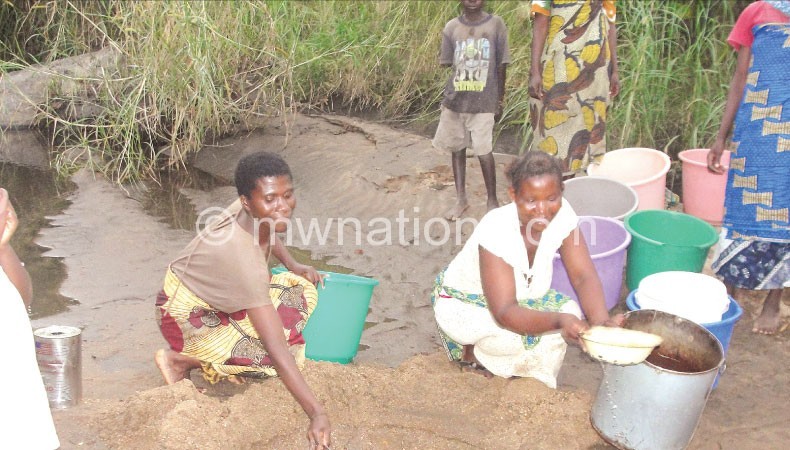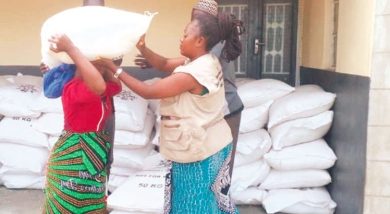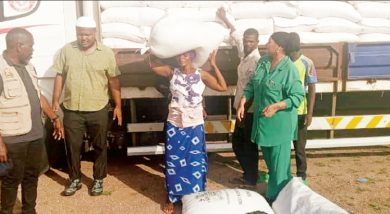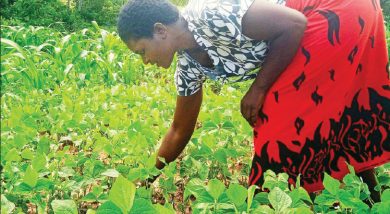Malawi drying up
Water is life, but the country is sitting on time bomb as it has become water limited with a reported decline of ground water and declining trends of in-flows in the last 10 years.
The decline, as confirmed by the Ministry of Agriculture, Irrigation and Water Development, has resulted in drying up of major rivers and low water levels in lakes and dams.

But the Ministry, which has attributed the low water levels to environmental degradation and climate change, has said it has embarked on interventions to address the challenge.
Said director of Water Resources in the Ministry, Modesta Kanjaye: “There has been a decline in flows for the last 10 years, apart from 2014/2015 rain season where the country received heavy rains and experienced floods. The decline in flows has resulted in drying up of the major rivers and low water levels in lakes and dams across the country.”
According to an assessment by experts, while the urban population is already stressed with erratic water supply— people in rural areas, face a looming disaster as their reliable water sources such as boreholes and wells are drying up.
BaseFlow, an NGO working in the water sector, says 30 percent of water points in rural areas such as wells and boreholes are drying up while rivers are turning into dust, creating more panic to the population which needs water to survive.
BaseFlow claims that the drying up of water points, especially boreholes, is as a result of the low water table.
“We have a looming disaster in this country. Ground water is no longer enough because the water table is going down,” Muthi Nhlema, Team Leader for BaseFlow, told Nation on Sunday in an interview.
Expert on Water and Irrigation at Lilongwe University of Agriculture and Natural Resources ( L u a n a r ) Associate professor Kenneth Wiyo, blamed the drying up of the country on overpopulation and drought.
“Malawi is becoming a water-stressed country mainly because of rapidly growing population. As a result, the per capita water supply is decreasing over time. Water is declining mainly because of frequent droughts [climate change issues] and changes in hydrology on account of environmental degradation,” said Wiyo.
According to Rhino Chiphiko, who owns a borehole drilling company, the average depth of a borehole in low-lying areas hovers around 50 to 60 metres while in upland areas, it takes an average of 80 metres to find water whereas in the past 10 years, they could easily find water at an average depth of 35 metres.
Owner of another drilling company, who opted for anonymity, attests to the fact that it is becoming harder to drill boreholes nowadays.
He said, for example, in lakeshore areas, it takes them an average of 45 to 55 metres to find water while in most parts of Mzimba, Balaka, and the Shire Valley it takes them over 80 metres of drilling to find the water Water Aid , a n International NGO, which strives to improve rural water supply in Malawi says it has encountered cases of declining underground water.
“Currently, we have a case in Kasungu where we are providing a reticulate water supply system to a health care facility and water was only found 720 metres [distance from designated area] away and this was after quiet a number of attempts by the contractor to find water. We have faced similar cases a few times in Kasungu and other areas as well,” said Annie Msosa, Water Aid head of programmes.
But Kanjaye said government is already implementing a hydrogeological and water quality mapping exercise to ensure that water shortage does not reach crisis level.
She said the implementation of the National Water Resources Act of 2013, which would allow for the formation of National Water Resources Authority (NWRA), would help to check environmental degradation in catchment areas.
“If this NWRA is operationalised, with formation of all envisaged catchment management boards, the situation may improve. It is hoped that these catchment management boards will assist checking environmental degradation in such catchments and sub-catchments, including promotion of artificial groundwater recharge,” she said, adding that some interventions are being implemented through donor-funded projects such as the Shire River Basin Management Programme as well as the Sustainable Rural Water and Sanitation Project.
In a response to a questionnaire, Lilongwe Water Board acting public relations officer Trevor Phoya said the board’s water capacity last year was reduced by two-thirds, leading to harsh water rationing with some areas having dry taps for days.
“We have experienced reduction in precipitation in recent years. While Lilongwe’s annual precipitation is supposed to range from 1 100 millimitres to 1 300 millimitres, this has not been the case in recent past years. In 2015 and 2016 rain season, our catchment area experienced about 700 mm and 600 mm, respectively,” he said.
Southern Region, Central Region, Blantyre and Northern Region Water boards have faced a similar challenge, forcing them, too, to think of other projects to enhance their capacity to cope with increase in population.
According to Northern Region Water Board (NRWB) spokesperson Edward Nyirenda, they have inadequate raw water sources for Mzuzu and Mzimba.
The current Lunyangwa Dam (for Mzuzu) was designed for the city’s population of 2005 while intake for Mzimba on Mzimba River can only sustain the town up to 2022.
Blantyre Water Board (BWB) through a multi-million credit line Exim Bank of India is planning to pump water from Likhubula in Mulanje to feed the commercial city and surrounding areas.
While Lilongwe Water Board (LWB) is also implementing multiple projects; raising the level of its dams Kamuzu 1 and 2, constructing multi-purpose Diamphwe Dam and tapping water from Lake Malawi as possible solutions to reach out to the city’s swelling population.
Asked on the sustainability of all these proposed projects by water boards, which call for heavy financing, Wiyo is skeptical in the absence of a clear study of environmental, social and financial implication of such undertakings.
On the Blantyre Likhubula water project, Wiyo thinks it is more viable given the amount of rainfall at Mulanje Mountain, which affords Likhubula River more water, but warns that this could only be sustained if environmental degradation of Mulanje Mountain is put under control.
The Luanar-based water expert also thinks the Likhubula water project maybe cost-effective because of gravity, which makes pumping of water easy and affordable.
Nhlema, who is also a civil engineer, is totally opposed to the idea of tapping water from Lake Malawi. He argues that water levels in the lake are going down; hence any intention to tap water from this source will worsen the situation.
Chairperson for a Parliamentary Committee on Agriculture, Water and Irrigation Chidanti Malunga said the current status quo calls for proper planning to avert catastrophe.






Healing the soil is one of the best ways to safeguard the nation against the effects of droughts and floods. Currently, much of the nation’s soil is ignored, burned, compacted, eroded, and left exposed to the sun. When heavy rains come, the water can not penetrate this hard-panned soil, allowing water to run off quickly, leading to massive flooding. Then, as very little water is absorbed by the soil, within a week of no rains, farmers begin complaining about ‘drought’. Many of the nation’s wells and rivers now run dry each year because the water table is not being replenished.
The two pictures below were taken on the same day in Chitedze during Malawi’s 2016 drought. The fields are about 100 meters apart from each other and both received the same amount of rainfall. The field on the left is a monocropped maize field, planted with expensive hybridized maize seed and synthetic fertilizers. The field on the right is an agroecological system, planted with free ‘local’ maize seed, intercropped with nitrogen-fixers and ground-covers, and heavily mulched to help absorb and hold the water in the soil. It is 100% organic (e.g. no synthetic fertilizers or chemicals), and the only ‘input’ needed was the labor for planting. The results speak for themselves and clearly show that Malawi has many locally-available solutions to restore the health of its ecosystems, protect our watersheds, and provide diverse food and nutrition security…for free!
https://uploads.disquscdn.com/images/2057e438e6cf87130717bcb1aa27b0e8b78931ef8abb8f469a817b04bfdb08cd.png
You seem to know what you’re talking about. “Tell them!”, as Kamuzu would have said.